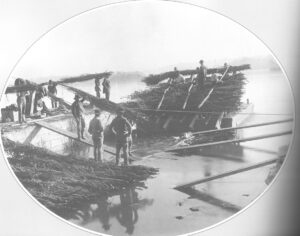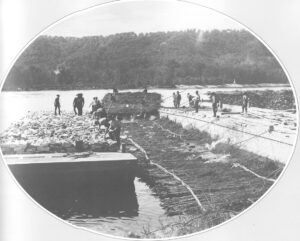The Fox Locks pre-date the Civil War, so there is a large body of historical information on the system. We are lucky to have an amateur historian on staff, and these are excerpts from Scott Thompson’s greater research into the system.
Don’t drink the water?
 Many communities along the Fox River used the river for drinking water and even in the early 1900s pollution was a concern. This article from Appleton Post dated June 23, 1910, outlines the conditions on the river and Little Lake Butte des Morts. At the time, wastewater treatment was still 20-30 years into the future and communities dumped sewage directly into the river. Residents and city leaders were always watching for cases of Scarlet Fever and other water-borne infections.
Many communities along the Fox River used the river for drinking water and even in the early 1900s pollution was a concern. This article from Appleton Post dated June 23, 1910, outlines the conditions on the river and Little Lake Butte des Morts. At the time, wastewater treatment was still 20-30 years into the future and communities dumped sewage directly into the river. Residents and city leaders were always watching for cases of Scarlet Fever and other water-borne infections.
Specifically, the article mentions that the lock master at the “first lock” in Appleton was called on to open the lock gates twice in a day to flush contaminants through the locks and navigation canal.
Original dam construction at De Pere
In 1835, Wisconsin was part of the Michigan Territory and statehood was still 13 years away. That didn’t stop a group of De Pere businessmen from “improving” the Fox River and they received permission from the Michigan legislature to build the original dam across the Fox River. That innovative design called for a construction style using rocks, mud, and brush. Steamboat captains referred to it as a “hazard to navigation.”
However, in a book by Henry Bosse who was with the Army Corps of Engineers, the rock and brush construction worked best on muddy river bottoms (like the Mississippi). If you’re interested, the book is Views on the Mississippi River between Minneapolis, Minn and St. Louis, Mo. 1883–1891. The silty mud moving downstream packs into the brush keeping it all in place. However, the rocky Fox River bottom at De Pere was much different and didn’t hold up.
The original dam at De Pere was replaced by a more robust version using quarried limestone with upgrades to follow using concrete with steel gates. Often, builders of these Fox River dams quarried the limestone right from the riverbed near the dam.
The photos below from the Bosse book show the rock and brush construction underway on a dam on the Mississippi in 1889. Look closely to see the bundled branches and small trees laid down first, followed by a layer of rocks.

